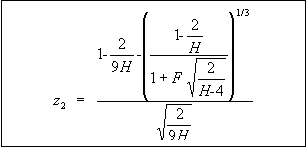U.S. Department of Transportation
Federal Highway Administration
1200 New Jersey Avenue, SE
Washington, DC 20590
202-366-4000
Federal Highway Administration Research and Technology
Coordinating, Developing, and Delivering Highway Transportation Innovations
 |
| This report is an archived publication and may contain dated technical, contact, and link information |
|
Publication Number: FHWA-RD-03-041 |
The following formulations for the combined skewness and kurtosis test were developed based on the reference [41].
For the skewness, we have:

Figure 76: Equation. Skewness definition.
For kurtosis, we have:

Figure 77: Equation. Kurtosis definition.
To evaluate the skewness and kurtosis tests results, the non-dimensional skewness and kurtosis coefficients are computed, as following:

Figure 78: Equation. Non-dimensional skewness coefficient definition.

Figure 79: Equation. Non-dimensional kurtosis coefficient definition.
Based on the g1 and g2 values, the statistics
![]() and b2 are found next:
and b2 are found next:

Figure 80: Equation. Definition of ![]() statistic.
statistic.

Figure 81: Equation. Definition of b2 statistic.
To find z1 value, the following parameters are computed using ![]() and b2 statistics:
and b2 statistics:

Figure 82: Equation. Definition of intermediate parameter A.

Figure 83: Equation. Definition of intermediate parameter B.
![]()
Figure 84: Equation. Definition of intermediate parameter C.

Figure 85: Equation. Definition of intermediate parameter D.

Figure 86: Equation. Definition of intermediate parameter E.
The corresponding z1 value used as a skewness test statistic is the following:

Figure 87: Equation. Definition of skewness test statistic z1.
To find z2 value, the following intermediate parameters are computed next:
![]()
Figure 88: Equation. Definition of the mean of intermediate parameter meanb2.

Figure 89: Equation. Definition of the variance of intermediate parameter varb2.

Figure 90: Equation. Definition of intermediate parameter F.

Figure 91: Equation. Definition of intermediate parameter G.

Figure 92: Equation. Definition of intermediate parameter H.
The corresponding z2 value used as a kurtosis test statistic is the following:

Figure 93: Equation. Definition of kurtosis test statistic z2.
The z1 and z2 statistics are used to obtain the p-values (the probability that values of the standard normal distribution are more extreme than the computed z1 and z2 statistics).